|
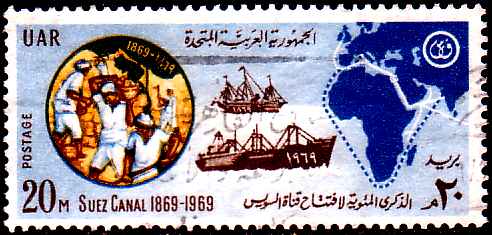
|
Maritime Topics On Stamps :
History of the Suez Canal!
| |
Trade between England and India was severely hampered by the long sailing times around the African continent.
The hatched line shows the long voyage all the way down south to the Cape of Good Hope, and then sailing the
whole stretch up again along the East coast of Africa. The white line in comparison shows the short passage
through the channel.
| |
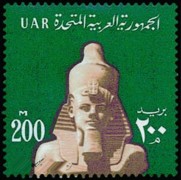
Pharao Ramses II.
|
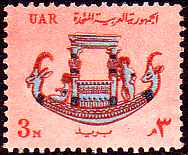
Bark from the burial treasure of Tut-ench-Amun
|
Already as in antique times a water way between the river Nile and the red sea was successfully finished.
Unfortunately the canal filled quickly with sand and mud. Political aspects were always more important than spending
on keeping the canal in good condition.
These were some of the first canals built:
- the 20. century before Christ was born Pharao Sesostries began work on a canal, which was finished by Amenemhet II. It lasted 200 years, until it was given up and became unusable.
- 100 years after Christ's birth., the roman emperor Trajan opened the "Canal of the Pharaoes", but it lasted a short time only.
- 600 a. C., Reopening of the Canal by the chief commander of Kalif Omar, Amr Ibn el As.
- 1500, Venice had plans for the cut through the Isthmus of Suez.
- 1671, Gottfried Wilhelm Leibnitz supported plans to again build a canal and wrote a letter of support to the French king Ludwig XIV.
- In 1798, after the invasion of Egypt, Napoleon planned a water link between the Mediterranean and the Red Sea. He ordered a commission to measure the difference in height between both seas and their result was of 9,908 m. The plan was given up.
- During the reign of Pharaoness Hatschepsut (1490 b.C.) a second attempt was started to cut thru the Isthmus connect from the river Nil to the red sea. But there was no money for maintaining the canal, and it filled soon up with mud.
- In the 13. century before Christ., Pharao Ramses II. started construction of another canal. However as the Lybiens invaded Egypt , the canal was no longer maintained and filled with sand.
- 6. century before Christ, Pharao Necho II. ordered work on a waterway to the Red Sea. 120.000 slaves were killed during the project, however the passage was not achieved .
- In the year 487 b.C., Darius I., king of Persia, completed the Necho canal."
|
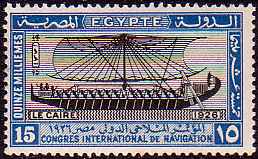
Relief aus dem Totentempel der Königin Hatschepsut
|

Boote auf dem Nil
|
- 100 years after Christ's birth., the roman emperor Trajan opened the "Canal of the Pharaoes", but it lasted a short time only.
- 600 a. C., Reopening of the Canal by the chief commander of Kalif Omar, Amr Ibn el As.
- 1500, Venice had plans for the cut through the Isthmus of Suez.
- 1671, Gottfried Wilhelm Leibnitz supported plans to again build a canal and wrote a letter of support to the French king Ludwig XIV.
- In 1798, after the invasion of Egypt, Napoleon planned a water link between the Mediterranean and the Red Sea. He ordered a commission to measure the difference in height between both seas and their result was of 9,908 m. The plan was given up.
|
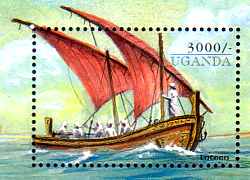
|
- 1825, founding of the "Societe d'etudes pour le canal de Suez" by the French Barthelmy Prosper Enfantin and the Englishman Ingenieur Stephenson. The project faltered.
- A study group British, French and Austrian experts determined in 1846, that the Red Sea and the Mediterranean Sea are almost equal in height. It would not be necessary to build locks.
- In 1856, the Austrian engineer Alois von Negrelli developed plans to build the Suez-Canal.
|
Graf Ferdinand Marie de Lesseps who was on a carrier path in the domestic administration of the French Foreign
Service, when he decided to try it big. 1850 he left the diplomatic corps. He went to Egypt and convinced the vice-king
of Egypt to give him the concession to build and operate the Suez Canal.
In 1858 the duke Marie de Lesseps founded the Suez canal company "Compagnie Universelle Du Canal Maritime
de Suez". Agreement was reached, that after 99 years, Egypt would regain possession of the canal zone and all
installations. 400.000 shares were issued, but only 186.000 were sold. 177.642 shares went to the vice king of
Egypt (which was part of the osmanic).
|
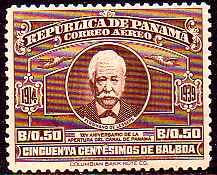
|
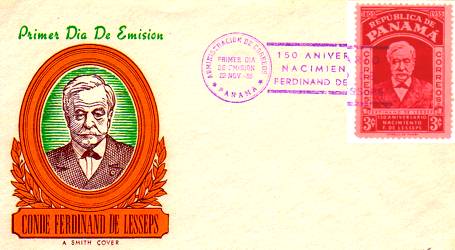
|
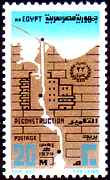
| |
On the 25th of April 1859 construction began in Port Said, at the northern end of the canal following Negrelli's plans.
Immense difficulties had to be overcome. All materials, all tools, machines, coal, iron, each piece of wood must be
gotten from Europe.
Another problem was to get potable water for the 25.000 workers. Of the 1.800 cargo-camels, which the company owned,
1.600 were solely busy getting the drinking water. After a while an additional canal was built to get sweet
water from the river Nile to the Isthmus, where the canal builders worked. This support canal was operational in 1863.
|
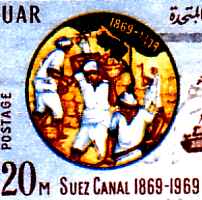
|
The workers were slaves, who did not need to be paid. The canal company had special relations with several sheiks, who got a per capita compensation for sending the requested number of slaves. Impressive technology was not necessary. There were no rocks, the slaves loosened the soil with simple hacks and carried the chunks of soil barehanded to the place, where the canal bank would be. The workers got no tents nor huts, they slept under the stars. Provisions and water were in short supply, until the sweet water canal was operational.
And because no hygienic installations such as toilets or places to wash themselves were available, epidemic outbreaks were likely.
Indeed, 1863/64, cholera and pocks struck, the workers deserted.
In total about 1.5 million people participated in the construction, about 125.000 people died, mostly killed by the cholera.
| |
In the middle of the 1860ies slavery was banned, and now the Canal Company was forced to get workers from all over the world - and pay them.
|
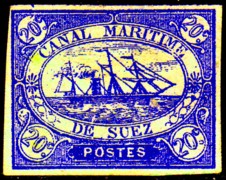
Stamp issued by the Canal Company
|
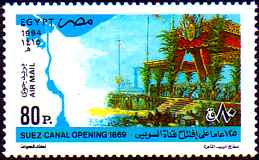
Tribune erected for the Opening Ceremonies
|
Finally, on the 18. of march, 1869 water from the Mediterranean sea was flowing into the Bitter Lake. On the 17. of
November 1869 the ceremonial opening of the canal was held. The first boat sailing through the canal was the
French yacht "L'Aigle". She is shown on the first stamp of this page, in the background.
Some of her data: L x B x T - 90 x 10,5 x 4,4 m, tdw 2.011, a sidewheel steamer, engine 2.000 PS, 15 kn. It is said, that
Giuseppe Verdi composed his opera "Aida" for this occasion. Since Aida was not ready in time for the opening ceremonies,
Rigoletto was given instead. (Aidas first performance was only two years later, 1871 in Kairo).
|
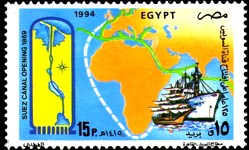
|
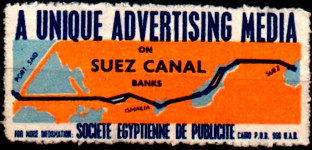
|
The length of the canal, which had to be digged, is only 162,5 km, while the total length of the water way is much
longer, 190,25 km. This is because it uses five lakes along its way. The canal begins in the north near Port Said and ends
in the south near Suez. The city Ismailia is almost half way through. It houses the seat of the Canal Company.
Today the canal's width is varying: in the north the width is 345 m at the water surface and 215 m down at the bottom.
At the south end the corresponding figures are 280 m and 195 m. Its depth is 22,5 m.
Indeed as predicted, the canal has no locks. The tide is only a few centimeters in the north. In the south however
it is between one and two meters. This causes a light current in the canal, which is no problem for the ships,
but slowly erodes the banks.
On route from London to Bombay the canal shortens the distance, which boats must sail by 4.563 nautical miles.
|
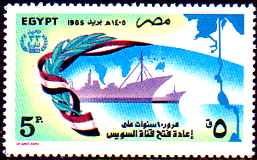
33. Anniversary of he Revolution 1985, Ships in the Canal
|
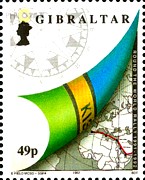
|
Boats with up to 62 ft draught are allowed through the canal. Presently the canal is deepened to 66 ft. whether a tanker
can pass the Suez-canal is its critical measure. Such tankers are called "Suezmax". This corresponds to approx.
120.000 to 165.000 tdw.
Four pilot stations are positioned along the canal. Only one- way traffic is possible. The boats are grouped
into convoys, and the convoys coming up from the south principally have the right of way. Up north, close to
El Ballah a short canal has been built to yield the right of way to the upcoming boats. Likewise the Big Bitter Lake and
the Timah Lake present opportunities to yield to other boats.
All boas must be equipped with a bow headlight. Passage through the canal takes 12 to 18 hours. The actual
time will depend on the direction of the convoy and possible wait time before the locks in front of Port Said and
Suez. The speed on the canal is limited to 13 to 14 km/h.
In its f irst year there were 486 passages only, 1887 there were 3.137 Ships through the Canal, today there are
15.000 boats passing thru annually. In the year 2006 the Egyptian State made 3,6 billions of US-Dollars. The fees
are calculated in terms of the Suez-NRT calculated, and each ship must carry its own "Suez Canal Special Tonnage
Certificate"; (72 Suez NRT equal 100 BRT).
|
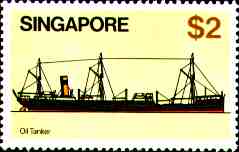
| The 'Murex' was the first tanker passing through the Suez back in 1892
| |
The Suez Canal was constantly a point of political arguments, interventions and wars. It began
with a law suit of the Canal society against the state of Egypt, to pay financial compensation, since the state had banned
the hard labor of slaves. In addition they requested, that Egypt pay for the costs of the sweet water canal.
Finally in Napoleon III. of France determined, that Egypt had to pay 84 millions of French francs.
And Egypt had to provide the salaries, to purchase machinery and was responsible for the food of the workers.
The country sold its Canal stock market shares for an apple and an egg to the UK, however did not succeed in
avoiding the state's bankruptcy. The UK held 44% of the Channel shares. Since then they were dominating the
canal consortium, since most of the remaining shares were widely spread over France.
|
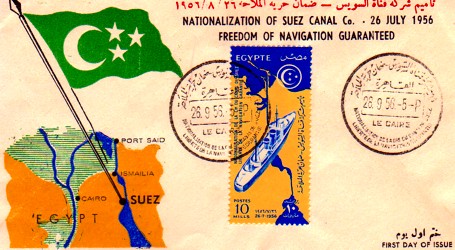
|

Nationalization of the Suez-Canal 1956
| |
England und France cooperated secretly and indirectly influenced the politics of the country.
The standard of living became worse. In the summer of 1878 actually 10.000 people starved. 1881 a riot broke out,
carrying the slogan "Egypt to the Egyptians." This was only just too welcome for the British, to again utilize
their Cannon-boat strategy. English war boats patrolled in front of Alexandria. The rebellion was suppressed and
Egypt occupied. Egypt had become a de-facto British colony.
|
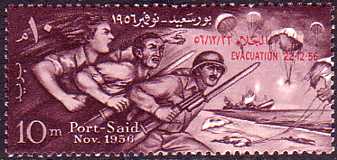
Egyptian Troops fighting landing parachute jumpers
|
|
1888 the Convention of Constantinople determined, that the Suez Canal become a neutral zone. Merchant- and navy
ships should always have free passage, in times of peace or war. Great Britain was in charge of maintaining peace,
which actually made the English forces stay in Egypt. In both World Wars there was again fighting for control of
the canal.
|
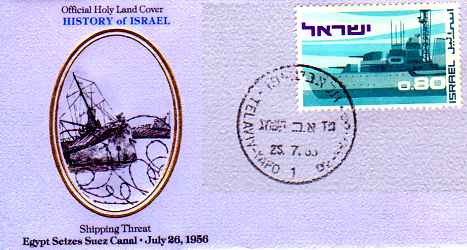
|

|
In 1922 the British protectorate was terminated, and Egypt became a kingdom. Nevertheless the UK still controlled the
canal zone. This was reassured by
a treaty in 1936. The Canal Company remained beneficiary of the canal.
|
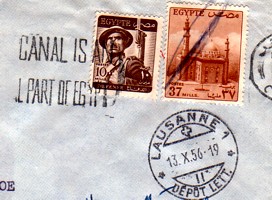
Suez Canal is an integral part of Egypt
|
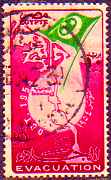
Watersupply area for the canal
|
In 1956 president Nasser of Egypt needed money for his Assuan Dam Project, which he could not get due to political
maneuvers of the American Foreign Minister. He one-sidedly occupied the canal on 26. of July, 1956.
This led to the Suez crisis.
The existing conflict between Egypt and Israel, who had to defend themselves against increasing numbers of
attacks by Fedajin from Egyptian territory, escalated. Egypt blocked the Golf of Akaba und closed the Suez canal for
Israeli boats. This was a clear violation of international law.
On 29. October 1956 Israeli, British and French forces attacked Egypt. However through intervention of the UN, the USA,
and the USSR the conflict was relatively quick ended and the invading armies left the fighting zone already
on 22. December 1956. However some sunk ships bared the passage until the end of 1957.
|
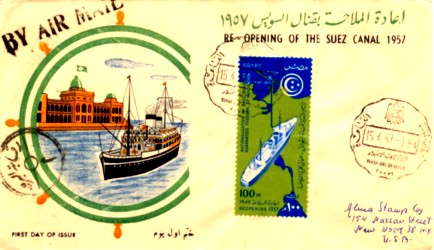
|
Reopening of the Canal 1957
|
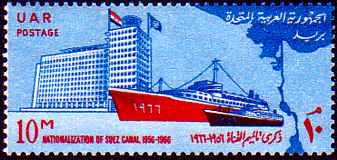
|
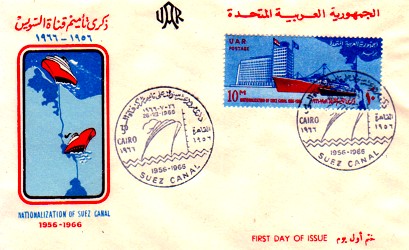
| |
10. Anniversary of the reopening in 1966; the building of the Channel company is seen in the backdrop of the picture.
|
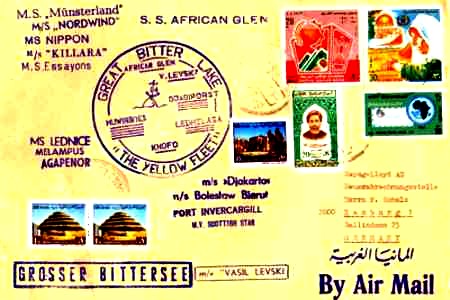
|
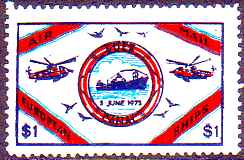
|
In 1967, the tensions between Egypt and Israel erupted again and unleashed another war. During this 6-day war
Israelis proceeded again to the east bank of the canal und occupied it completely. The Six-daý-war actually the
answer to the closing of the street of Tiran for Israeli vessels and an Arabic concentration of troups along the
limits of Israeli country.
A convoy of 14 merchant vessels was still in the canal and had to toss anchor in the large Bitterlake.
While the war lasted only 6 days, these ship were actually locked in for eight years inside the canal, because it was
closed from 1967 until 1975. In October of 1973 Egyptian forces broke through the East Bank blockade und Israel
retreated its soldiers from the whole canal zone.
And when the cleaning work started, 12 ships and several barges had to be raised, and as if it were not enough
110 000 items of ammunition recollected.
|

|
To the trapped ships see the elaborate "Maritime Topics on Stamps" page
Great Bitter Lake Locals.
|

Fighting zones in 1973, Präsident Sadat.
|
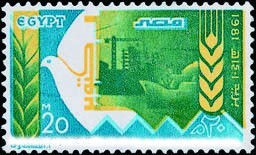
1981, 8. Anniversary of the Suez-Canal crossing.
| |
|
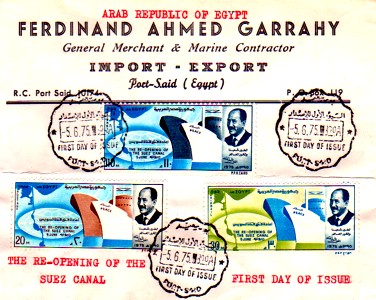
Reopening of the canal 1975
|
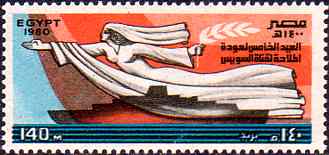
1980, 5. Anniversary of the reopening of the Suez-Canal, an angel of peace protects the cruise boat.
|
|
Reopening of the Canal 1975,
the Greek vessel "Olympos" is allowed to pass with a cargo of goods for the Israeli port Eilat!
|

|

|
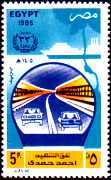
| |
Bridge at El Kantara over, and the Ahmed Hamdi Tunnel under the Suez-Canal, which is 14 km north of Suez.
|
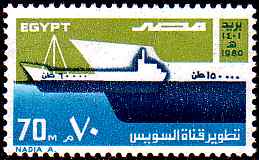
1980 Opening of the third arm of the Suez-Canal
|
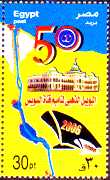
2006, 50 years Nationalization of the Canal
|
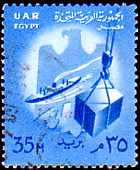
Loading goods, symbolic for a growing Trade
|
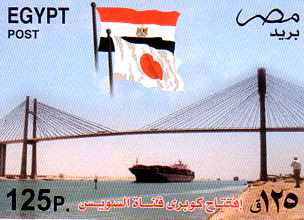
|
Sources:
Wikipedia Internet Enceclopedia
W. Fellmann, Schiffe im Nadelöhr, VEB Brockhaus
|
|